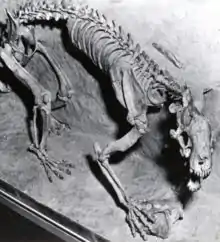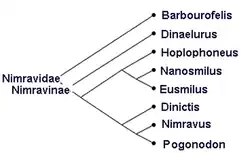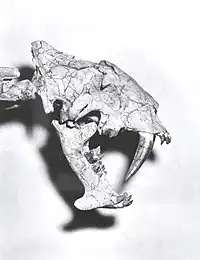Nimravidae
The Nimravidae is an extinct family in the Carnivora. It is a type of cat-like mammal in the suborder Feliformia. They lived in North America, Europe, and Asia from the Eocene through the Miocene epochs, 42–20 million years ago (mya). They lasted for about 22 million years.[1]
| Nimravidae Temporal range: Middle Eocene to Late Miocene, | |
|---|---|
 | |
| Hoplophoneus mentalis | |
| Scientific classification | |
| Domain: | Eukaryota |
| Kingdom: | Animalia |
| Phylum: | Chordata |
| Class: | Mammalia |
| Order: | Carnivora |
| Suborder: | Feliformia |
| Family: | †Nimravidae Cope, 1880 |
| Genera | |
| |


Although some nimravids physically resembled the sabre-toothed cats of genus Smilodon, they were not closely related, but evolved a similar form through parallel evolution.
The ancestors of nimravids and felids diverged from their common ancestor about 50 mya. Most had muscular, low-slung, catlike bodies, but with shorter legs and tails.
Teeth
Some nimravids did evolve into large toothed cat-like forms with massive flattened upper canines and mandibular flanges.[2] Others had teeth similar to modern cats, with smaller canines. Some had canines more intermediate relationship between the saber-toothed cats and felids. These differences must have reflected different methods of attacking their prey.
Not only did nimravids have varied tooth styles, but they also showed the same range of size size and shape as felids. Some were leopard-sized, others the size of today's lions and tigers, and one had the short face, rounded skull and smaller canines of the modern cheetah.
References
- "PaleoBiology Database: Nimravidae, basic info". Archived from the original on 2008-04-30. Retrieved 2012-07-09.
- The function of these flanges was to protect the flattened canine teeth.